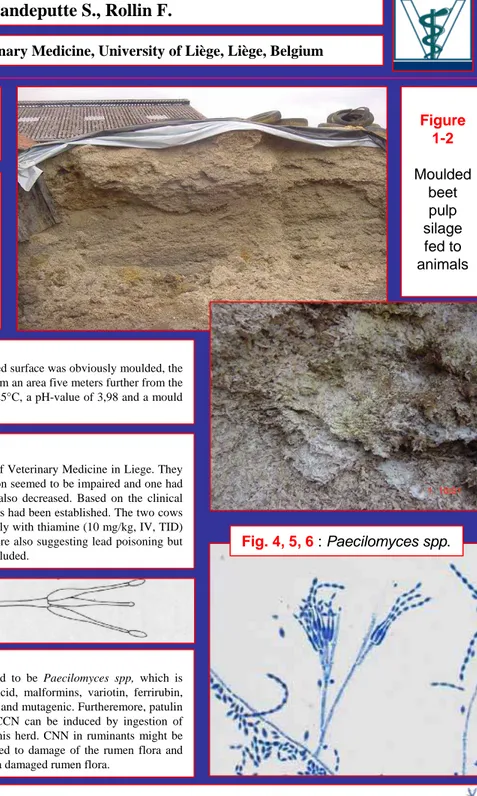Case Report : A suspicion of cortico-cerebral necrosis in a Belgian Blue herd after ingestion of moulded silage
Case report
Until August 2002, the dual purpose BB herd was kept on the pasture and supplemented with corn silage. Two weeks after the beginning of the progressive introduction of beet pulp silage into the usual corn silage ration, most of the animals showed diminished appetite, ptyalism and decreased milk production. All 35 cows were reluctant to consume the beet pulp silage, but continued to eat grass silage voluntarily (when bringing in for milking). Seven of them showed anorexia and nervous symptoms, like head pressing and blindness. Four animals died within 1 week after onset of neurological symptoms. No necropsy has been performed, since legislation does not allow post-mortem examination of the central nervous system in the field.
The spoiled silage had been discarded from the ration of the animals and symptoms disappeared. Four weeks later, the same beet pulp silage has been accidentally reintroduced into the animals’ ration and provoked again diminished appetite, ptyalism and a decrease in milk production in most of the animals. These symptoms disappeared again after beet pulp silage had been discarded from their ration.
Discussion
Silage was obviously moulded and analysis revealed a mould content of 1.6 million CFU/g of silage. The mould species had been identified to be Paecilomyces spp, which is taxonomically closely related to penicilline. Paecilomyces spp are able to produce the following mycotoxins : paecilotoxins, byssochlamic acid, malformins, variotin, ferrirubin, viriditoxin, indole-3-acetic acid, fusigen and patulin. Among these substances, patulin has been demonstrated to be toxic, teratogenic, cancerogenic, and mutagenic. Furtheremore, patulin is known to have a marked negative effect on rumen microbes and feed fermentation in vitro (1). Although, it has not been described that CCN can be induced by ingestion of
Paecilomyces spp., there is an obvious close relation between ingestion of Paecilomyces-contaminated silage and the observed clinical signs in this herd. CNN in ruminants might be
caused by a disturbed rumen flora that is incapable of producing thiamine (2, 3). It is suspected that the ingestion of patulin containing silage led to damage of the rumen flora and consequently to CNN. Other symptoms, like loss of appetite, decreased milk production and diminished ruminal activity might also be explained by a damaged rumen flora.
Figure
1-2
Moulded
beet
pulp
silage
fed to
animals
Fig. 3
:
BB-heifer
showing
head
pressing
Fig. 4, 5, 6
: Paecilomyces spp.
Clinical findingsTwo of the affected cows had been admitted to the Faculty of Veterinary Medicine in Liege. They showed teeth grinding, circling and head pressing. Their vision seemed to be impaired and one had bilateral mydriasis and strabism. The rumen’s activity was also decreased. Based on the clinical signs and anamnesis, the diagnosis of cortico-cerebral necrosis had been established. The two cows as well as a third one, at the farm had been treated successfully with thiamine (10 mg/kg, IV, TID) and recovered completely within five days. Clinical signs were also suggesting lead poisoning but any contact with lead containing material could have been excluded.
I
ntroductionAfter ingestion of Paecilomyces spp.-contaminated beet pulp silage, cases of cortico-cerebral necrosis (CCN) and mortalities have been observed in a dual purpose Belgian Blue (BB) herd. Cases had been successfully treated with high doses of thiamin after avoidance of the contaminated silage. Similar cases of CCN reoccurred after ingestion of that silage.
The silage
A farm visit allowed closer inspection of the silage and revealed a slightly darker than usual beet pulp silage. A layer of 20 to 40 cm under the covered surface was obviously moulded, the temperature in this region was 38° C (air temperature : 17°C) and the pH-value was 4,15. A sample taken from this area and a core sample, taken from an area five meters further from the cut front showed a mould content of 1.6 million CFU/g of silage. The rest of the silage seemed to be in good condition and had a temperature of 25°C, a pH-value of 3,98 and a mould content of 30 CFU/g of silage.
Bibliography
(1) Morgavi DP, Boudra H, Jouany JP, Graviou D. Prevention of patulin toxicity on rumen microbial fermentation by SH-containing reducing agents. J Agric Food Chem. 2003. 51:6906-10. (2) Haven TR, Caldwell DR, Jensen R. Role of predominant rumen bacteria in the cause of polioencephalomalacia (cerebrocortical necrosis) in cattle. Am J Vet Res. 1983. 44:1451-5. (3) Edwin EE, Markson LM, Shreeve J, Jackman R, Carroll PJ. Diagnostic aspects of cerebrocortical necrosis. Vet Rec. 1979. 104:4-8.
